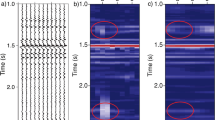Abstract
In this work, new strategies for automatic identification of P- and S-wave arrival times from digital recorded local seismograms are proposed and analyzed. The database of arrival times previously identified by a human reader was compared with automatic identification techniques based on the Fourier transformation in reduced time (spectrograms), fractal analysis, and the basic matching pursuit algorithm. The first two techniques were used to identify the P-wave arrival times, while the third was used for the identification of the S-wave. For validation, the results were compared with the short-time average over long-time average (STA/LTA) of Rietbrock et al., Geophys Res Lett 39(8), (2012) for the database of aftershocks of the 2010 Maule M w = 8.8 earthquake. The identifiers proposed in this work exhibit good results that outperform the STA/LTA identifier in many scenarios. The average difference from the reference picks (times obtained by the human reader) in P- and S-wave arrival times is ∼ 1 s.















Similar content being viewed by others
References
AlBinHassan NM, Luo Y, Al-Faraj MN (2006) 3D edge-preserving smoothing and applications. Geophysics 71(4):P5–P11
Allen R (1978) Automatic earthquake recognition and timing from single traces. Bull Seismol Soc Am 68(5):1521–1532
Allen R (1982) Automatic phase pickers: their present use and future prospects. Bull Seismol Soc Am 72(6B):S225–S242
Anant KS, Dowla FU (1997) Wavelet transform methods for phase identification in three-component seismograms. Bull Seismol Soc Am 87(6):1598–1612
Baer M, Kradolfer U (1987) An automatic phase picker for local and teleseismic events. Bull Seismol Soc Am 77(4):1437–1445
Bai CY, Kennett B (2000) Automatic phase-detection and identification by full use of a single three-component broadband seismogram. Bull Seismol Soc Am 90(1):187–198
Cichowicz A (1993) An automatic S-phase picker. Bull Seismol Soc Am 83(1):180–189
Dai H, MacBeth C (1995) Automatic picking of seismic arrivals in local earthquake data using an artificial neural network. Geophys J Int 120(3):758–774
Durka P, Blinowska K (1995) Analysis of EEG transients by means of matching pursuit. Ann Biomed Eng 23(5):608–611
Earle PS, Shearer PM (1994) Characterization of global seismograms using an automatic-picking algorithm. Bull Seismol Soc Am 84(2):366–376
Jones JP, van der Baan M (2015) Adaptive STA–LTA with outlier statistics. Bull Seismol Soc Am 105(3):1606–1618
Joswig M (1990) Pattern recognition for earthquake detection. Bull Seismol Soc Am 80(1):170–186
Klinkenberg B (1994) A review of methods used to determine the fractal dimension of linear features. Math Geol 26(1):23–46
Korvin G (1992) Fractal models in the earth sciences. Elsevier Science Ltd
Küperkoch L, Meier T, Brüstle A, Lee J, Friederich W (2012) Automated determination of S-phase arrival times using autoregressive prediction: application to local and regional distances. Geophys J Int 188(2):687–702
Küperkoch L, Meier T, Lee J, Friederich W, Group EW et al (2010) Automated determination of P-phase arrival times at regional and local distances using higher order statistics. Geophys J Int 181(2):1159–1170
Mallat SG, Zhang Z (1993) Matching pursuits with time-frequency dictionaries. IEEE Trans Signal Process 41(12):3397–3415
Mandelbrot BB (1983) The fractal geometry of nature: W. H. Freeman and Company
Nippress S, Rietbrock A, Heath A (2010) Optimized automatic pickers: application to the ANCORP data set. Geophys J Int 181(2):911–925
Peters EE (1994) Fractal market analysis: applying chaos theory to investment and economics, vol 24. Wiley
Phillips PJ (1998) Matching pursuit filters applied to face identification. IEEE Trans Image Process 7(8):1150–1164
Rawles C, Thurber C (2015) A non-parametric method for automatic determination of P-wave and S-wave arrival times: application to local micro earthquakes. Geophys J Int 202(2):1164–1179
Rietbrock A, Ryder I, Hayes G, Haberland C, Comte D, Roecker S, Lyon-Caen H (2012) Aftershock seismicity of the 2010 Maule mw = 8.8, Chile, earthquake: Correlation between co-seismic slip models and aftershock distribution Geophys Res Lett 39(8)
Rinehart AJ, McKenna SA, Dewers TA (2016) Using wavelet covariance models for simultaneous picking of overlap** P- and S-wave arrival times in noisy single-component data. Seismological Research Letters
Ross ZE, Ben-Zion Y (2014a) An earthquake detection algorithm with pseudo-probabilities of multiple indicators. Geophys J Int 197(1):458–463
Ross ZE, Ben-Zion Y (2014b) Automatic picking of direct P, S seismic phases and fault zone head waves. Geophys J Int 199(1):368–381
Sabbione JI, Velis D (2010) Automatic first-breaks picking: new strategies and algorithms. Geophysics 75(4):V67–V76
Sugihara G, May RM (1990) Applications of fractals in ecology. Trends Ecol Evol 5(3):79–86
Turcotte DL (1989) Fractals in geology and geophysics Fractals in geophysics. Springer, pp 171–196
Turcotte DL (1997) Fractals and chaos in geology and geophysics
Vincent P, Bengio Y (2002) Kernel matching pursuit. Mach Learn 48(1-3):165–187
Wang Y (2006) Seismic time-frequency spectral decomposition by matching pursuit. Geophysics 72 (1):V13–V20
Acknowledgements
We thank Andreas Rietbrock for the use of his STA/LTA software in this study, and also the anonymous reviewers who contributed to the improvement of our work. This research was supported by FONDECYT, Project 1130071. J. F. Silva acknowledges support from the Advanced Center for Electrical and Electronic Engineering, Basal Project FB0008.
Author information
Authors and Affiliations
Corresponding author
Rights and permissions
About this article
Cite this article
Chi-Durán, R., Comte, D., Díaz, M. et al. Automatic detection of P- and S-wave arrival times: new strategies based on the modified fractal method and basic matching pursuit. J Seismol 21, 1171–1184 (2017). https://doi.org/10.1007/s10950-017-9658-0
Received:
Accepted:
Published:
Issue Date:
DOI: https://doi.org/10.1007/s10950-017-9658-0



